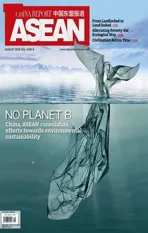RIDING CHINA-ASEAN CULTURAL WAVES EMERGING OPPORTUNITIES FOR COOPERATION BETWEEN CHINA AND ASEAN IN CULTURAL AND CREATIVE INDUSTRIES
2019-10-11ByHaoNan
By Hao Nan
Coined by economists as “dragon” and “tiger” economies in late 20th Century, Southeast Asian countries like Singapore, Malaysia, Thailand, the Philippines, Indonesia and others have sent Asian waves across the world alongside the Northeast Asian pioneers. Thanks to the ASEAN regional grouping, Southeast Asia has earned a central role in regional politico-economic cooperation architecture, attracting all major Asia-Pacific powers to negotiate with the body, even from the Indo-Pacific region. However, while Chinese, Japanese and South Korean pop culture has swept across and beyond the region in recent years, ASEAN countries seem to be tuning out in recent times.
With the significant economic structural shifts in global scale brought by disruptive technologies, various countries including ASEAN member states are searching for new and sustainable high valueadded growth points. Perhaps the time is ripe for another round of “Look East” with focus on cultural and creative industries. Against the backdrop of China's further opening of its market and the ongoing Belt and Road Initiative, a trial is quite feasible through ASEAN countries' cooperation with China.

Thai actress Chutimon Chuengcharoensukying, star of the film Bad Genius, and Taiwanbased actor Vivian Dawson take a selfie with fans at the Beijing International Film Festival on April 15, 2018.
A New Direction
During the post-WWII economic rise of greater East Asia, which was called the Flying Geese Paradigm, Japan was deemed the head goose followed by Four Asian Dragon Economies (South Korea, Hong Kong, Taiwan and Singapore) and later Asian Tiger Economies (Malaysia, Thailand, Indonesia, the Philippines and Vietnam) as wings. As Japan, South Korea and China are reaching for higher value-added growth points including in their respective cultural and creative industries, ASEAN countries seem to be missing the chance.In terms of the wider cultural and creative industrial landscape of East Asia, Japan has produced the most globally recognized brands in ACG (anime, comics and games). In 2016 alone, its revenue reached 2,001 billion yen (around US$18 billion). South Korea has enjoyed a boom in exports of its TV dramas, movies and K-pop. In 2016, K-pop alone earned estimated global revenues of over US$4.7 billion.
As East Asian economies championed industrial policies that have successfully developed their manufacturing industries, cultural and creative industries soon grabbed attention. Immediately after the 1997 financial crisis, President Kim Dae-Jung of South Korea called for a culture-industryoriented national development strategy when the country was economically weak, which kindled an eventual explosion of Korean cultural exports to the world. Around roughly the same time, Japan also identified the cultural industry as a target for growth in its 21st Century culture-oriented national development scheme which eventually evolved into the 2010 Cool Japan strategy that is predicted to earn 1 trillion yen in cultural revenues by 2020.
Arriving later but in larger scale, at a faster speed and in more innovative ways, China's cultural and creative industries, driven by a huge hungry middle class with consumer cultural demands, thriving digitalization and robust policy support, now account for over 4 percent of its GDP. A series of cultural and creative products have emerged on the market such as mobile apps, TV series, movies, music and animation. Some of the products have even gained noticeable popularity throughout Southeast Asia. Major international players include the short video app Tik Tok, the mobile game Arena of Valor and the TV drama Story of Yanxi Palace.
Southeast Asian Culture Slipping from Chinese Social Memories
Southeast Asian countries once played a significant role in producing global social memories, particularly in China. Bonded by similar ideologies and historical ties, in the 20th Century China conducted frequent cultural exchanges with the CLMV countries in mainland ASEAN: Cambodia, Lao PDR, Myanmar and Vietnam. Vietnam was among the few countries exporting movies to China before its reform and openingup. Throughout the 1960s and 70s, at least 18 Vietnamese movies were subtitled and screened in Chinese cinemas.
With the economic rise of the “dragons” and “tigers” and a new cultural wave radiating from Hong Kong, cultural products from Southeast Asian countries including Singapore and Malaysia started flooding into Chinese market thanks to cultural familiarity. The first wave was led by Hong Kong movies, many of which were actually shot in Thailand due to production costs. In the 1980s, Singapore was a particularly vibrant cultural player in China thanks to TV dramas like The Awakening, People on the Journey and Paint a Rainbow. Seizing the opportunities afforded by China's opening-up, these shows earned Singapore huge popularity among a generation of Chinese and left fuzzy feelings in Chinese mainland social memories.
However, with the subsequent influx of cultural products from Europe, America, Japan and South Korea, Southeast Asian countries have been gradually squeezed out of the Chinese market as well as social memories.
Some ASEAN countries attempted to reverse course during the decline, but policy discontinuity ultimately left the trend irreversible. For example, in the late 1990s, the Singapore government had already embraced the concept of cultural and creative industries in a 15-year Renaissance City Plan aiming to develop the city into a gateway to Asia by leveraging its cultural capital. But after completion of the first 15-year plan, the second never came.
Making Moves
ASEAN is a culturally unique and diverse region hosting most of the main world religions. With long-standing cultural exchanges with neighboring countries like China, it has great potential to tap in cultural and creative industries.
US$1 8 billion
Japan has produced the most globally recognized brands in ACG. In 2016 alone, its revenue reached 2,001 billion yen (around US$18 billion).
US$4.7billion
South Korea has enjoyed a boom in exports of its TV dramas, movies and K-pop. In 2016, K-pop alone earned estimated global revenues of over US$4.7 billion.
UmiSllio$n 11.4
In 2018, the Philippines witnessed a local movie gross over 600 million pesos (US$11.4 million)at the box office, a record figure.

Suppanad Jittaleela (left), a Thai actress who became popular in China for her role in the film Yes or No, appears at the Thai Festival in Kunming, southwestern China's Yunnan Province, on May 12, 2015.
Things are happening. ASEAN member states have achieved consensus on protecting, promoting and utilizing ASEAN's cultural diversity and then building an ASEAN Socio-Cultural Community, one of three pillars of the ASEAN Community as well as the ASEAN Strategic Plan for Culture and Arts. Individual countries are also making strides. In 2015, Indonesia's Jokowi administration mandated the establishment of the Creative Economy Agency (BEKRAF), aiming to nurture growth of film, fashion, music, handicrafts and other creative industries. Driven by the cultural consumption demands of the large emerging middle class in the region, individual markets have seen delightful success in local content production and circulation. In 2018, the Philippines witnessed a local movie gross over 600 million pesos(US$11.4 million) at the box office, a record figure.
Northeast Asia is taking action as well. All three Northeast Asian countries, China, Japan and South Korea, have issued respective southbound policies towards the ASEAN region, among which, China's efforts have stood out. On the macro level, China's ongoing Belt and Road Initiative is working to tap the cultural potential of ASEAN and China by synergizing ASEAN's relevant initiatives and masterplans with China's. Recent years of China-ASEAN cooperation have been designated through bilateral consensus as devoted to tourism, innovation and cultural cooperation. With China's pledge to further open its huge market to facilitate outflow of investment, technology and education, Southeast Asian countries have witnessed growth in all elements involved in cultivating cultural and creative industries such as creativity, digital literacy, capital investment and consumer markets. On the micro level, a series of cooperative projects have solidified into a regular mechanism. A few permanent players include the ASEANChina Film Festival, College of Chinese and ASEAN Arts launched by Chengdu University, ASEAN-China Arts Colleges Alliance, ASEANChina Culture Forum and the China-ASEAN Expo Cultural Exhibition.
Such initiatives and mechanisms may still be new, but fruits of cooperation have already ripened for ordinary Chinese consumers. In recent years, Thailand's movies saw an upsurge both in popularity and revenues in the Chinese market. One example was Bad Genius, a small-budget movie that turned out to be so popular among Chinese viewers that it earned much more revenues in China than in Thailand. The same success also happened with Thai TV dramas like Love Destiny.
A Chinese saying goes: “Friendship, which derives from close contact between peoples, holds the key to sound international relations.” This is true both for ASEAN's internal pursuit of one vision, one identity and one community and the group's external relations with China. Solid cultural foundations between peoples are particularly significant. They serve not only as the cornerstone of bilateral relations and cooperation but also a stepping stone for business communities to leverage cultural potential into highly beneficial cultural and creative industries.
杂志排行
China Report Asean的其它文章
- SEIZING SUSTAINABLE SOLUTIONS CHINA SETS THE STANDARD FOR ALLEVIATING POVERTY AND PROMOTING ONGOING GROWTH
- PAGODA CITY Unforgettable memories in Bagan
- CIVILIZATION BEFORE TIME Archaeological Ruins of Liangzhu City named a UNESCO World Heritage Site
- RULES OF ATTRACTION Southeast Asian universities emerge as a new choice for Chinese students
- THE BOOK ON CULTURAL EXCHANGE A Chinese-Malaysian publishing MoU sets the stage for extensive cooperation
- CHINESE HIGH-TECH AG IN CAMBODIA New collaboration on harvesting rice and cotton
